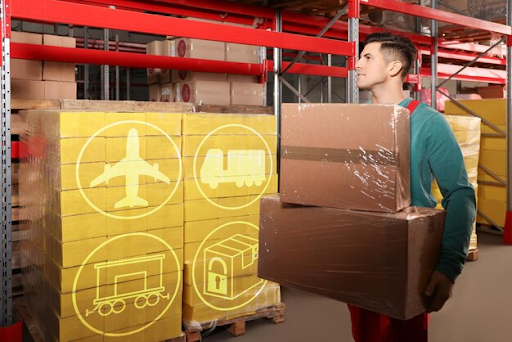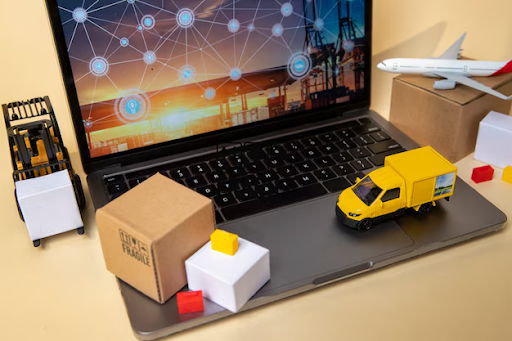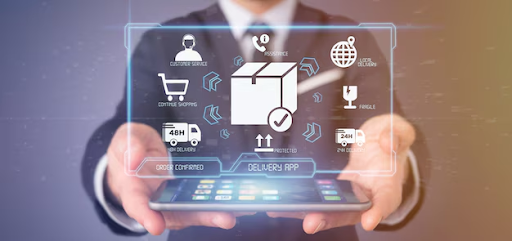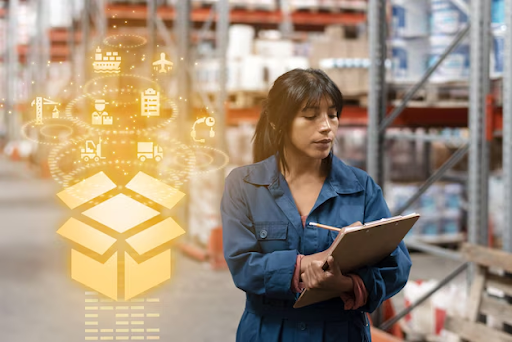Reverse logistics, the process of managing the flow of returned goods, is becoming increasingly important in the modern supply chain. However, traditional processes often face many challenges regarding cost and efficiency. This article will explore how advanced technology applications are addressing these issues, opening up new opportunities for businesses to optimize Reverse Logistics operations, not only reducing costs but also creating differentiation and strengthening competitive positions in the market.
In this blog, let's explore the key technological applications that are reshaping the Reverse Logistics sector, helping businesses optimize every aspect of the process and surpass their competitors.
1. What is Reverse Logistics? Why is it important?

1.1. Definition of Reverse Logistics
Reverse Logistics, also known as recovery logistics, is the process of planning, implementing, and controlling the efficient flow and storage of goods, services, and related information from the final consumption point back to the origin point (or processing point) with the aim of recovering value or properly handling it.
In simpler terms, Reverse Logistics includes all activities related to the movement of used, defective, or no longer needed goods from customers back to the business or relevant parties to perform tasks such as:
- Returns: Customers return products due to dissatisfaction, defects, or discrepancies with the description.
- Warranty and repair: The product is sent back for warranty or repair.
- Product recall: The business recalls the product for safety, quality, or regulatory reasons.
- Recycling: Sorting and processing recyclable parts or materials.
- Reuse: Refurbishing or repairing products to resell or use for other purposes.
- Handling: Dispose of or process products that are no longer usable safely and in compliance with regulations.
Unlike Forward Logistics, which focuses on delivering products from manufacturers to consumers, Reverse Logistics focuses on the reverse flow of goods and information.
1.2. Why is Reverse Logistics becoming increasingly important?
In the context of modern business, Reverse Logistics is no longer a secondary activity but has become a key factor, bringing many benefits and profoundly impacting the success of enterprises. The importance of Reverse Logistics is increasingly growing due to many factors:
Customer factor:
Expectations for an easy and quick return process: With the development of e-commerce, customers increasingly expect flexible return policies and simple processes. An effective Reverse Logistics process will enhance customer experience, increase satisfaction, and foster loyalty.
Influencing purchase decisions: A convenient return policy can be a decisive factor for customers to choose to buy your company's products instead of those of competitors.
Environmental factors:
Pressure regarding social responsibility and sustainable development: Consumers and regulatory agencies are increasingly concerned about environmental issues. Effective Reverse Logistics helps businesses manage waste, recycle resources, minimize negative environmental impacts, and demonstrate social responsibility.
Compliance with legal regulations: Many countries and regions have enacted strict regulations regarding the collection and disposal of used products (e.g., electronic waste). Reverse logistics helps businesses comply with these regulations and avoid legal penalties.
Economic factors:
Opportunity to recover value from returned products and materials: Instead of viewing returned goods as a cost, effective Reverse Logistics helps businesses recover value through recycling, refurbishing, reselling, or reusing parts. This can create a new source of revenue and minimize waste.
Cost reduction: An optimized Reverse Logistics process can help businesses reduce transportation, storage, return handling, and warranty-related costs.
Competitive factor:
Create a market distinction: Efficient Reverse Logistics can become a unique competitive advantage, helping businesses stand out from their competitors.
Enhancing customer loyalty: A positive return experience can strengthen the relationship with customers and encourage them to return for future purchases.
Provide valuable information: Data collected from the Reverse Logistics process (e.g., reasons for returns, product condition) can provide important insights for the production, design, and marketing departments to improve product quality, service, and business strategy.
Reverse Logistics is not merely the handling of returned goods but also an important strategic factor that affects customer satisfaction, business efficiency, environmental responsibility, and the long-term competitiveness of the enterprise.
2. Key technology applications in Reverse Logistics

2.1. Advanced Warehouse Management System (WMS):
Warehouse Management System (WMS) plays an important role in optimizing storage and operational processes in warehouses. However, with the development of technology and the increasing demands from businesses, upgrading WMS to meet new needs has become an inevitable trend. One of the most important improvements in advanced WMS is the ability to effectively track and manage returned goods, optimize storage space, and integrate with other systems.
First, tracking and managing returned goods has become an indispensable factor. With modern identification technologies such as barcodes, QR codes, or RFID, the system can easily identify and classify returned goods accurately. Goods can be classified according to their condition, such as intact, damaged, or unsatisfactory, thereby helping warehouses manage more efficiently. Moreover, the inventory of returned goods also becomes accurate and quick thanks to the automated inventory tool, ensuring that the quantity of goods in the warehouse is always accurate and updated in a timely manner.
Next, optimizing storage space is an important factor that cannot be overlooked in an advanced WMS. The system can allocate warehouse space rationally, designating areas for returned goods, areas for intact goods, and areas for items with different statuses. With space optimization algorithms, the system will automatically adjust the allocation of goods based on their size, weight, and condition, thereby saving warehouse space and enhancing storage efficiency. Along with that, managing the flow of goods in the warehouse will also become more flexible, enhancing the efficiency of searching and retrieving goods.
Finally, one of the strengths of advanced WMS is its ability to integrate with other systems such as the Transportation Management System (TMS). When WMS is connected to TMS, the goods transportation process will be automated and synchronized between departments. This helps optimize delivery schedules, minimize errors, and enhance work efficiency. Additionally, integrating data from other systems makes tracking and managing return orders easier, while also providing detailed information about the status of goods to the relevant departments.
2.2. Intelligent Transportation Management System (TMS)
The intelligent transportation management system (TMS) is increasingly playing an important role in optimizing the transportation process, especially in the collection of returned goods. One of the standout features of the smart TMS is its ability to plan and optimize return pickup routes. By using optimization algorithms, the system can plan the most efficient routes, minimizing transportation time and costs.
TMS also allows for real-time tracking of the location and status of shipments. Thanks to GPS technology and IoT sensors, stakeholders can update information about the shipment at any time, ensuring accuracy and transparency during the transportation process.
Additionally, the smart TMS supports the automation of coordination processes and communication with transportation partners, helping to minimize errors and enhance work efficiency. The system can automatically send notifications and update the status of shipments to transportation partners, thereby creating a seamless and synchronized workflow. Smart TMS not only enhances transportation efficiency but also helps save costs and time, bringing significant benefits to the entire supply chain.
2.3. Internet of Things (IoT) and sensors
Internet of Things (IoT) and sensors are becoming important technologies in enhancing the efficiency of warehouse and transportation management. One of the important applications of IoT is monitoring the storage conditions of goods throughout the transportation and storage process, especially factors such as temperature and humidity. IoT sensors can continuously monitor and record these parameters, helping to ensure that goods are stored under ideal conditions and avoid damage.
In addition, IoT also helps monitor the status and location of assets such as containers and pallets throughout the transportation process. Through GPS sensors and motion sensors, managers can accurately track the location and condition of important assets, thereby minimizing the risk of loss and damage.
Finally, IoT supports the collection of accurate and timely data, providing management systems with complete and up-to-date information about the status of goods. This not only helps improve decision-making capabilities but also enhances transparency and efficiency in the supply chain, contributing to the optimization of operations and cost reduction.
2.4. Artificial Intelligence (AI) and Machine Learning: Enhancing Return Management
Artificial intelligence (AI) and machine learning are playing a crucial role in optimizing the returns processing workflow. With the ability to predict return rates and the demand for processing returns, AI can analyze historical data and consumer trends to forecast future scenarios. This helps businesses better prepare for the volume of returns and optimize resources.
AI and machine learning also help optimize the process of classifying and routing returned goods such as recycling, repairing, or disposing of them, thereby minimizing waste and costs. By analyzing data, AI can make automated decisions on the most efficient way to handle returns. In addition, AI also helps analyze data to identify the reasons for returns, thereby improving product and service quality, which helps reduce the return rate in the future.
Read more: Digital Supply ChainTransforming: Business Operations With AI and IoT
2.5. Blockchain: Enhancing Transparency and Trust
Blockchain is bringing many benefits in enhancing transparency and traceability of the origin of products and returned materials. Thanks to the immutable and secure nature of blockchain, information related to the production, transportation, and recycling processes of products can be accurately recorded and tracked. This helps ensure the authenticity of information in the recycling and returns processing procedures.
Additionally, blockchain helps build customer trust in the company's commitment to sustainability, as customers can easily trace information about the processing and recycling of products, thereby fostering trust and brand loyalty.
2.6. Mobile Application and Customer Portal: Improving User Experience
Mobile applications and customer portals provide convenience for customers in requesting returns and tracking the status of their requests. Through the application, customers can easily submit return requests, receive detailed information about the return process and available options, providing them with a more convenient and transparent experience.
In addition, these applications also help collect customer feedback on reverse logistics experiences, thereby providing valuable data to improve processes and services. This not only enhances customer satisfaction but also helps businesses improve operational efficiency and reduce issues related to returns.
2.7 ERP - data integration and intelligent system management
Enterprise Resource Planning (ERP) systems are increasingly becoming an indispensable part of modern organizations thanks to their ability to integrate data and manage systems intelligently. One of the greatest advantages of ERP is its ability to link different departments within an organization, from inventory management, finance, and human resources to production and sales, helping to optimize operational processes and create a unified working system.
ERP allows for the integration of data from various sources, enabling departments to access information simultaneously and ensuring accuracy in all activities. This is especially important when quick decisions need to be made, such as inventory management, production optimization, or order coordination. By aggregating and analyzing data from multiple systems, ERP helps businesses grasp the overall picture of the business situation and develop more effective growth strategies.
In addition, the intelligent system management features in ERP help automate many processes, reduce human errors, and enhance work efficiency. With the support of artificial intelligence (AI) and machine learning, the ERP system can predict trends, optimize work schedules, and allocate resources efficiently. This not only saves time and costs but also helps businesses respond quickly to market changes.
Read more: What is ERP? Features and benefits of implementing an ERP system
3. Benefits of applying technology in Reverse Logistics

Applying technology to Reverse Logistics brings significant benefits to businesses, from optimizing operational processes to enhancing customer experience. Here are some notable benefits:
Optimizing the Processing Workflow
Returned Goods Technologies such as Artificial Intelligence (AI) and Machine Learning help predict return rates and the need for processing returned goods, optimize collection routes, and classify goods (recycling, repair, disposal). This helps reduce operational costs and processing time, thereby saving resources and improving efficiency.
Improve Customer Experience
The use of the mobile application and customer portal helps customers easily request returns and track the status of their requests. Detailed information about the return process and available options helps customers have a more convenient and transparent experience, thereby enhancing satisfaction and loyalty.
Enhancing Transparency Transparency and Safety
The application of Blockchain in reverse logistics helps enhance transparency and traceability of returned product origins, ensuring the authenticity of information related to recycling and processing procedures. This not only enhances customer trust but also supports businesses in their commitment to sustainability and brand protection.
More Accurate Inventory and Asset Management
Internet of Things (IoT) technology and sensors allow for monitoring the storage conditions of goods (temperature, humidity) and tracking the status as well as the location of assets such as containers and pallets. Thanks to this, businesses can ensure that goods are transported and stored under the best conditions, avoiding damage and loss.
Enhancing Data Prediction and Analysis Processes
Data analytics technology helps predict the reasons for returns and optimize processes, thereby improving the quality of products and services. This not only reduces the return rate but also helps businesses improve their business and product strategies, creating a market difference.
Reduce Costs and Enhance Flexibility
The application of advanced technologies helps automate many processes in reverse logistics, minimizing human intervention and operational costs. At the same time, businesses can easily adapt to changes in demand and the market, ensuring efficient and flexible operations.
4. Challenges and considerations when implementing

Although the application of technology in Reverse Logistics brings many benefits, the implementation process is not without challenges. Businesses need to pay attention to several important issues to ensure success in applying technology to Reverse Logistics.
High Investment Cost
Challenge: The implementation of new technologies such as AI, IoT, Blockchain, or ERP systems requires a significant initial investment for software and hardware procurement, as well as employee training. Small or medium-sized enterprises may struggle to meet these financial requirements.
Businesses need to carefully plan their finances and evaluate ROI (Return on Investment) to ensure that the initial investment costs will be compensated by long-term benefits. One option is to implement in phases, starting with low-cost technologies that provide high efficiency.
Difficulties in System Integration
Challenge: Warehouse Management Systems (WMS), Transportation Management Systems (TMS), and other technologies may not be compatible with the existing system. The integration between new technologies and old systems can be challenging and time-consuming.
Businesses need to choose technology solutions that offer flexible integration capabilities and support APIs (Application Programming Interface) to ensure compatibility. Working with software vendors and technology experts to plan the integration is very important.
Ensuring Data Security and Privacy
Challenge: The use of technologies such as IoT and Blockchain requires a large amount of data to be collected and shared between systems, increasing the risk of security breaches and information loss.
Businesses need to focus on investing in security measures such as data encryption, multi-factor authentication, and system protection solutions. Ensuring compliance with data security regulations such as GDPR (General Data Protection Regulation) or other international standards is mandatory.
Training Human Resources and Changing Corporate Culture
Challenge: New technology requires a team of employees with specialized skills and knowledge to use it effectively. The transition from traditional processes to the use of advanced technology may face resistance from employees.
Businesses need to invest in training and skill development programs for employees, creating an environment that supports change. Clearly communicating the benefits of new technology and how it will make work more efficient is crucial to gaining the consensus of the staff.
Ability to Ensure Service Quality
Challenge: When applying technology to Reverse Logistics, reliance on automated systems can lead to service quality issues if not continuously monitored and adjusted.
Businesses need to have a team to continuously monitor and inspect automated processes to ensure they operate as expected. Data analysis and reporting tools can help quickly identify issues and provide timely solutions.
Big Data Management
Challenge: With the development of technologies such as IoT and AI, businesses will collect a vast amount of data. Managing and analyzing this volume of data can be challenging without the right tools and strategies.
Businesses need to invest in a robust data storage system and use intelligent data analysis tools to process and extract valuable information from the collected data.
5. Conclusion
In summary, in the digital age, the application of technology to Reverse Logistics is no longer an option but has become a key factor for businesses to survive and develop sustainably. From intelligent warehouse management systems, optimal transportation management, to the power of IoT, AI, Blockchain, and mobile applications, technology is opening new doors to address the inherent challenges of Reverse Logistics.
Therefore, businesses need to proactively grasp trends, research, and implement advanced technological solutions into their Reverse Logistics processes. This is not only a necessary step to address current issues but also a smart strategy to build a stronger and more competitive business future. Let's transform Reverse Logistics from a "mandatory cost" into a "secret weapon" that brings superior advantages to your business. Contact us to receive free materials and consultations on the latest technological solutions.